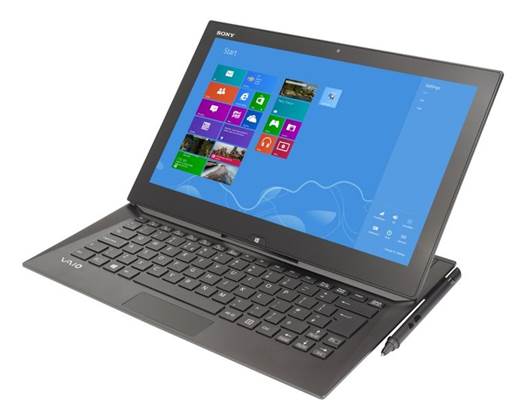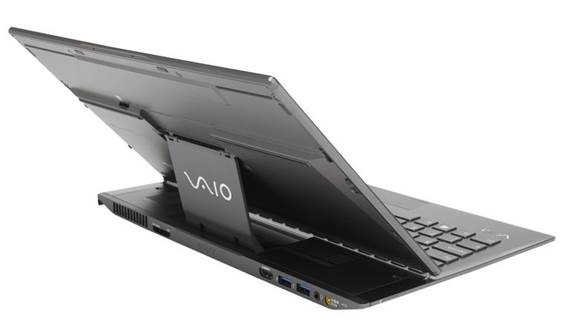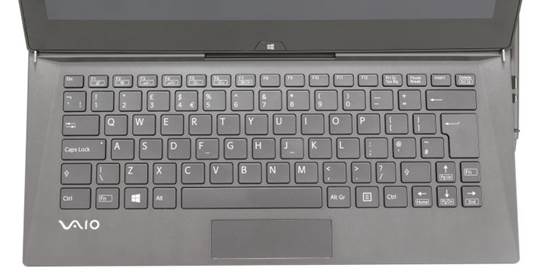Sony Vaio Duo 13 is a major improvement for the
Windows 8 slider.
When Sony’s Vaio Duo 11 slider released
late last year, its powerful performance and vivid HD screen were not enough
for us to ignore a flawed design and unimpressive battery life. The Duo 13,
just unveiled at Computex; there seems to be a great second effort. Many things
have changed here, from an advanced hinge and a larger battery to a higher
price: from $1,200 up to $1,400. Oh, and it also provides a wider keyboard and
a suitable touchpad. Is Sony’s second attempt a success, especially if you are
considering the $200 premium? Let's find out.

Sony
Vaio Duo 13 is priced at $1,400
Design
We cannot "self-praise" ourselves
too much here, but Sony certainly seems to have considered our criticism - and
the other reviews – of the Duo 11. The device looks better this time, and
indeed, regardless of the larger 13.3-inch screen, the computer weighs only
2.93 pounds, which is slightly heavier than its predecessor (2.87 pounds). This
is thanks to the carbon fiber structure, which is lighter than the aluminum
alloy used on the older models. We still have painful memories of the jagged
edges of the Duo 11, so we're pleased to announce that Sony chose a more
rounded frame this time. The company also ensured that the screen and the
keyboard base are arranged perfectly in the tablet mode, reducing the
possibility of which you will be likely to impale your wrists while completing
a Bing search.

The
company also ensured that the screen and the keyboard base are arranged
perfectly in the tablet mode, reducing the possibility of which you will be
likely to impale your wrists while completing a Bing search.
Sony has completely overhauled its hinge
design. The so-called Surf Slider mechanism on the Duo 13 is much easier to
trigger, we are able to pull out the screen with just one hand. This time
slider mechanism feels much more solid, putting the device into tablet mode
feels more secure and stable rather than wobbly. The hinge also looks much
better, because the cable system is now placed behind the hinge rather than
exposed.

Sony
has completely overhauled its hinge design. The so-called Surf Slider mechanism
on the Duo 13 is much easier to trigger, we are able to pull out the screen
with just one hand.
On the front of the slider, you will find
the Windows 8 Start button along with a 2MP front-facing camera and Sony
branding. Pulling the screen up reveals the Vaio logo on the keyboard (a bigger
version of this is etched on the hinge itself). All of the ports are located at
the rear edge of the Duo 13, while the right and left sides are completely
blank. Sony says the new arrangement gives you a better grip when you are using
the device in tablet mode, and it is also a nod to the graphic designers who
would prefer to keep the cables in the rear to get tidier workspace. All in
all, you have an SD card slot, HDMI, two USB 3.0 ports, a headphone jack and
the power connector. The high-end configurations including Windows 8 Pro will
also come with a VGA adapter. Turn the device back over; you'll see a speaker
grille as well as Assist and Volume buttons. Finally, there is an 8MP camera,
which lies on the left side instead of the center.

All
of the ports are located at the rear edge of the Duo 13, while the right and
left sides are completely blank. You have an SD card slot, HDMI, two USB 3.0
ports, a headphone jack and the power connector.
Keyboard, trackpad and stylus
By design, the sliding computers have
limited keyboard space - that's how they adapt to the slide-out screen. Sony
attempted to reduce this inconvenience by moving the screen a little backward
on this model. As a result, you have a larger group of island-style chiclets.
The backlit layout, of course, feels as cramped as the Duo 11’s, and the volume
is also greater here, which is highly appreciated. We will not call the
keyboard large, it really is, but the keys are large enough to reduce the
surprisingly error rate on the typing tests.

By
design, the sliding computers have limited keyboard space - that's how they
adapt to the slide-out screen. Sony attempted to reduce this inconvenience by
moving the screen a little backward on this model. As a result, you have a
larger group of island-style Chiclets.
Although it may be small, the touchpad is a
respectable addition to the Vaio Duo slider. Sony replaced the optical pointing
stick and left- and right- click buttons with a full Synaptics clicker, which
makes scrolling, pinch-to-zoom and other gestures become smoother. However, do
not think this is a flagship tracker; its small size makes the actions such as
copying and pasting become challenging, because it requires a little strategy
to deal with the limited space. One note: Sony said its latest trackpad will
provide a slightly more certain button press, although we did not have any
problems with the trackpad on our tested model.
The N-Trig digitizer that ships with is
slightly heavier this time, and that's a good thing. It feels better in the
hand, and the pressure-sensitive stylus still does a superb job of drawing and
transcribing with both the pen tips. Meanwhile, the Duo 11 did not provide a
slot for storing the pen; this model gives you two options: a stylus clip is
attached to the right side of the device, and a horizontal slide-out hook that
lets you hook up the pen at an angle, similar to an ink jar. To use the clip,
you insert it into a slot on the back of the Duo 13, and then slide the
stylus’s handle to attach it. Now you just need to make sure that you do not
lose this little piece of plastic.

The
pressure-sensitive stylus still does a superb job of drawing and transcribing
with both the pen tips.
Sony also added the "pen wake"
functionality (wake up the pen) to work with this smart storage idea. An MR
sensor installed on the system will detect when you remove the pen and will
automatically wake up the system from the sleep mode. You are likely to
configure the feature to launch a special program when the pen is removed, such
as Note Anytime. It is rather similar to what we saw on the Galaxy Note 10.1,
but it is a convenient trick, and it seems to work fairly well.